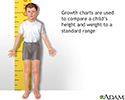Short stature
Idiopathic short stature; Non-growth hormone deficient short stature
A child who has short stature is much shorter than children who are the same age and sex.
Your health care provider will go over your child's growth chart with you. A child with short stature's height is:
- Two standard deviations (SD) or more below the average height for children of the same sex and age.
- Below the 2.3rd percentile on the growth chart: Out of 1,000 boys (or girls) who were born on the same day, 977 of the children are taller than your son or daughter.
Considerations
Your child's provider checks how your child is growing at regular checkups. The provider will:
- Record your child's height and weight on a growth chart.
- Monitor your child's growth rate over time. Ask the provider what percentile your child is for height and weight.
- Compare your child's height and weight to other children of the same age and sex.
- Talk with you if you are worried that your child is shorter than other children. If your child has short stature, this does not necessarily mean that something is wrong.
Causes
There are many reasons why your child has short stature.
Most of the time, there is no medical cause for short stature.
- Your child may be small for her age, but is growing OK. She will probably start puberty later than her friends. Your child will most likely keep growing after most of her peers have stopped growing, and will probably be as tall as her parents. Providers call this "constitutional growth delay."
- If one or both parents are short, your child will most likely also be short. Your child should get as tall as one of her parents.
Sometimes, short stature may be a symptom of a medical condition.
Bone or skeletal disorders, such as:
Long-term (chronic) diseases, such as:
- Asthma
- Celiac disease
- Congenital heart disease
- Cushing disease
- Diabetes
- Hypothyroidism
- Inflammatory bowel disease
- Juvenile rheumatoid arthritis
- Kidney disease
- Sickle cell anemia
- Thalassemia
Genetic conditions, such as:
Other reasons include:
- Growth hormone deficiency
- Infections of the developing baby before birth
- Malnutrition
- Poor growth of a baby while in the womb (intrauterine growth restriction) or small for gestational age
This list does not include every possible cause of short stature.
When to Contact a Medical Professional
Contact your provider if your child appears to be much shorter than most children their age, or if they seem to have stopped growing.
What to Expect at Your Office Visit
The provider will perform a physical exam. The provider will measure your child's height, weight, and arm and leg lengths.
To figure out possible causes of your child's short stature, the provider will ask about your child's history.
If your child's short stature may be due to a medical condition, your child will need lab tests and x-rays.
Bone age x-rays are most often taken of the left wrist or hand. The provider looks at the x-ray to see if the size and shape of your child's bones have grown normally. If the bones have not grown as expected for your child's age, the provider will talk more about why your child may not be growing normally.
Your child may have other tests if another medical condition may be involved, including:
- Complete blood count
- Growth hormone stimulation
- Thyroid function tests
- Insulin growth factor-1 (IGF-1) level
- Blood tests to look for liver, kidney, thyroid, immune system, and other medical problems
Your provider keeps records of your child's height and weight. Keep your own records, too. Bring these records to your provider's attention if the growth seems slow or your child seems small.
TREATMENT
Your child's short stature may affect their self-esteem.
- Check in with your child about relationships with friends and classmates. Kids tease each other about many things, including height.
- Give your child emotional support.
- Help family, friends, and teachers emphasize your child's skills and strengths.
TREATMENT WITH GROWTH HORMONE INJECTIONS
If your child has no or low levels of growth hormone, your provider may talk about treatment with growth hormone injections.
Most children have normal growth hormone levels and will not need growth hormone injections. If your child is a boy with short stature and delayed puberty, your provider may talk about using testosterone injections to jump-start growth. But this is not likely to increase adult height.
References
Cooke DW, DiVall SA, Radovick S. Normal and aberrant growth in children. In: Melmed S, Auchus RJ, Goldfine AB, Koenig RJ, Rosen CJ, eds. Williams Textbook of Endocrinology. 14th ed. Philadelphia, PA: Elsevier; 2020:chap 25.
Cuttler L, Misra M, Koontz M. Somatic growth and maturation. In: Jameson JL, De Groot LJ, de Kretser DM, et al, eds. Endocrinology: Adult and Pediatric. 7th ed. Philadelphia, PA: Elsevier Saunders; 2016:chap 22.
Escobar O, Viswanathan P, Witchel SF. Pediatric endocrinology. In: Zitelli BJ, McIntire SC, Nowalk AJ, eds. Zitelli and Davis' Atlas of Pediatric Physical Diagnosis. 7th ed. Philadelphia, PA: Elsevier; 2018:chap 9.
Marcdante KJ, Kliegman RM. Short stature. In: Marcdante KJ, Kliegman RM, eds. Nelson Essentials of Pediatrics. 8th ed. Philadelphia, PA: Elsevier; 2019:chap 173.
Review Date: 8/10/2021
Reviewed By: Neil K. Kaneshiro, MD, MHA, Clinical Professor of Pediatrics, University of Washington School of Medicine, Seattle, WA. Also reviewed by David Zieve, MD, MHA, Medical Director, Brenda Conaway, Editorial Director, and the A.D.A.M. Editorial team.














